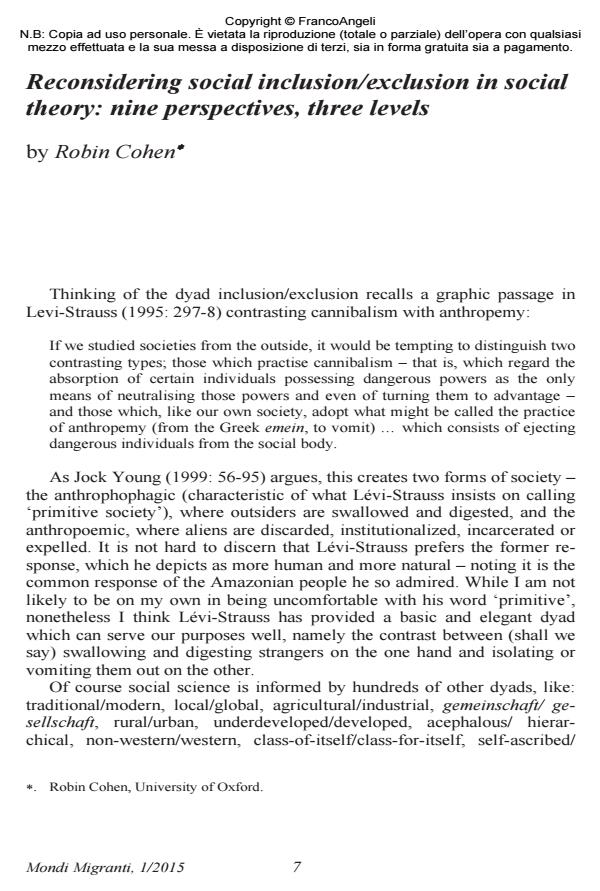Reconsidering social inclusion/exclusion in social theory: nine perspectives, three levels
Titolo Rivista MONDI MIGRANTI
Autori/Curatori Robin Cohen
Anno di pubblicazione 2015 Fascicolo 2015/1
Lingua Inglese Numero pagine 23 P. 7-29 Dimensione file 87 KB
DOI 10.3280/MM2015-001001
Il DOI è il codice a barre della proprietà intellettuale: per saperne di più
clicca qui
Qui sotto puoi vedere in anteprima la prima pagina di questo articolo.
Se questo articolo ti interessa, lo puoi acquistare (e scaricare in formato pdf) seguendo le facili indicazioni per acquistare il download credit. Acquista Download Credits per scaricare questo Articolo in formato PDF

FrancoAngeli è membro della Publishers International Linking Association, Inc (PILA)associazione indipendente e non profit per facilitare (attraverso i servizi tecnologici implementati da CrossRef.org) l’accesso degli studiosi ai contenuti digitali nelle pubblicazioni professionali e scientifiche
A dyadic mode of reasoning is used to consider social behaviour and practices that generate social inclusion and exclusion in contemporary globalized societies. After reviewing definitions of social inclusion/exclusion and their relationship to one another, the author examines nine perspectives on social exclusion and three levels of societal analysis through which social theorists attempt to understand inclusionary/exclusionary dynamics, processes and outcomes. Special attention is then given to the issues of inclusion/exclusion with regard to migration and citizenship and to the emergence and employment of these concepts in contemporary debates.
Per prendere in considerazione il comportamento e le pratiche che generano inclusione/esclusione sociale nelle società globalizzate di solito è usata una modalità ragionamento di tipo diadico. Dopo aver esaminato le definizioni di inclusione/ esclusione sociale e la loro reciproca relationship, l’autore esamina nove prospettive inerenti l’esclusione sociale e tre livelli di analisi della società attraverso i quali i sociologi tentano di comprendere le dinamiche di inclusione/esclusione, i relativi processi e i conseguenti risultati . Speciale attenzione è quindi data ai temi dell’inclusione/esclusione per quanto riguarda la migrazione e cittadinanza e alla nascita e l’impiego di questi concetti nei dibattiti contemporanei.
Parole chiave:Inclusione sociale; esclusione sociale; pensiero diadico ; esclusione multidimensionale; migrazione
- Education of children with disabilities in New Delhi: When does exclusion occur? Parul Bakhshi, Ganesh M. Babulal, Jean-Francois Trani, Stefano Federici, in PLOS ONE /2017 pp.e0183885
DOI: 10.1371/journal.pone.0183885 - Strangers and Migrants in the Making of African Societies: A Conceptual and Historical Review Robin Cohen, in Fudan Journal of the Humanities and Social Sciences /2019 pp.45
DOI: 10.1007/s40647-017-0203-x
Robin Cohen, Reconsidering social inclusion/exclusion in social theory: nine perspectives, three levels in "MONDI MIGRANTI" 1/2015, pp 7-29, DOI: 10.3280/MM2015-001001